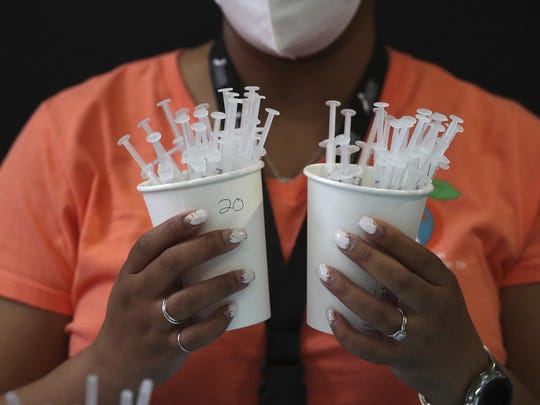Pfizer-BioNTech COVID-19 vaccine proves safe and effective for kids ages 12 to 15, company study shows

The COVID-19 vaccine from drug company Pfizer and its German partner BioNTech vaccine is safe for and extremely effective in adolescents, according to a company-sponsored study released early Wednesday.
In adolescents 12 to 15 years old, vaccination led to a higher protective antibody response than in adults and was seen to be 100% effective against symptomatic disease, the study of 2,260 adolescents found.
The two-shot Pfizer-BioNTech vaccine had been authorized for use in those 16 and up based on previous trials, but not in younger adolescents.
Last week, the companies began testing their vaccine in children ages 5 to 11; next week, they will begin testing in ages 2 to 5, and later will look at children 6 months to 2 years. Results from those trials should be available later this year.
Moderna, which also has a COVID-19 vaccine, has been studying its shot in teenagers since December, and launched a trial in younger children in mid-March. That vaccine is not yet approved for use in older teens.
Fulton County Department of Public Health registered nurse Rosalie Pringle prepares dozens of Pfizer COVID-19 vaccinations at Mercedes-Benz Stadium on Wednesday in Atlanta. (Photo: Curtis Compton/Atlanta Journal-Constitution via AP)
Pfizer-BioNTech plan to submit their adolescent data to the U.S. Food and Drug Administration to ask that their authorization to provide BNT162b2 be quickly amended to include that age group. It’s not clear how long the FDA will take to review the request.
Albert Bourla, chairman and CEO of Pfizer, said in a prepared statement that he hoped to make the vaccine rapidly available to younger adolescents.
“We share the urgency to expand the use of our vaccine to additional populations and are encouraged by the clinical trial data from adolescents between the ages of 12 and 15,” he said. “We plan to submit these data to FDA as a proposed amendment to our Emergency Use Authorization in the coming weeks and to other regulators around the world, with the hope of starting to vaccinate this age group before the start of the next school year.”
Where did the virus come from? When did the outbreak begin? Five takeaways from the WHO’s report on the origins of the pandemic
In the trial, 18 adolescents who received a placebo came down with COVID-19, but none in the vaccinated group, the companies said. Side effects in adolescents were consistent with those observed in participants 16 to 25 years old.
All participants will be monitored for two years after their second dose to track long-term protection and safety
The BNT162b2 vaccine, like those from Moderna and Johnson & Johnson, has received emergency use authorization rather than full FDA approval. To save time during the pandemic, the companies were allowed to provide two months of safety data, instead of waiting the full two years to see whether the vaccine will remain effective. Serious side effects, if any, are mostly likely to occur within the first six weeks after vaccination.
Allison Oler, 17, receives her Pfizer vaccination, Wednesday, March 24, 2021, in Sandy, Utah. All adults in Utah aged 16 and older became eligible to receive COVID-19 vaccinations Wednesday. (AP Photo/Rick Bowmer) (Photo: Rick Bowmer, AP)
It remains unclear how long the COVID-19 vaccines will remain protective, but trial results and real-world data suggest the Moderna and Pfizer-BioNTech vaccines are more than 90% effective at preventing symptomatic COVID-19.
Hospitalizations and severe disease appear to be extremely rare after vaccination with two doses of both vaccines.
So far, 96 million Americans – nearly 30% – have received at least one dose of the three vaccines, according to the Centers for Disease Control and Prevention. More than 75 million of those doses have been the Pfizer-BioNTech vaccine, nearly 69 million have gotten Moderna, and just over 3 million adults have received the single-dose J&J shot.
Contact Karen Weintraub at [email protected].
Health and patient safety coverage at USA TODAY is made possible in part by a grant from the Masimo Foundation for Ethics, Innovation and Competition in Healthcare. The Masimo Foundation does not provide editorial input.
Source: Read Full Article


